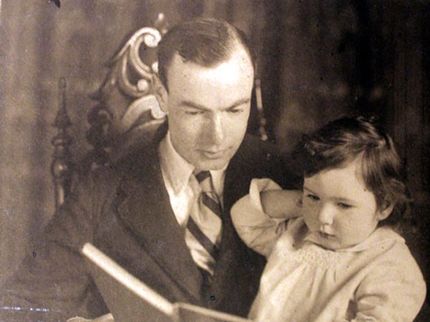Barbara Newhall Follett was a child prodigy.
By the age of 12, she had published her first novel, titled The House Without Windows. She first completed it at the age of nine, then rewrote it from memory after the original manuscript was lost in a fire. The New York Times praised the work, as did Eleanor Farjeon, a famed English author of children’s books. Farjeon wrote, “I don’t know what to call this book, except a miracle.” Two years later, Barbara wrote her second novel, The Voyage of the Norman D. Several more works followed, and the future looked bright.
But three months before she turned 26, Barbara disappeared without a trace. To this day, the reasons behind her disappearance remain a mystery.

Barbara and her father.
Barbara was born on March 4, 1914, to writer Wilson Follett and his wife Helen. She was an enterprising child, with an obsessive fascination for letters and words. At three years old, she wandered into her father’s office and found his typewriter. To the delight of her father, Barbara became transfixed by the machine.
Related: Lady Vanishes: the Mysterious Agatha Christie Disappearance
By the time she turned five, Barbara’s mother Helen was homeschooling her. This allowed Barbara ample time for her creative pursuits. She began writing a tale called The Life of the Spinning Wheel, the Rocking-Horse, and the Rabbit. When she started writing her first full-length novel at age eight, she routinely brushed her friends aside in favor of more literary tinkering. During these childhood years, Barbara also created an imaginary world called “Farksolia,” for which she developed a language and vocabulary.
Finally, in 1926, The House Without Windows was finished. At over 40,000 words, the story concerned, (by Barbara’s own description) “a child who ran away from loneliness, to find companions in the woods—animal friends.”
Wilson Follett had been working for Knopf in New York, and passed his daughter’s novel along to the publisher. They approved it for publication, and in February 1927, the positive reviews poured in. Fame came suddenly for the young girl. H. L. Mencken even wrote to her parents with his congratulations.

But dark clouds soon gathered.
In the midst of a mid-life crisis, Wilson Follett decided to leave his family for a younger woman. Young Barbara was devastated. Helen tried to be optimistic, and took her daughter on a long sailing voyage throughout the Caribbean. Mother and daughter even co-authored a book about their travels, which was eventually published in 1932 as Magical Portholes.
Unfortunately, by 1929, there was little money left. When the Great Depression struck later that year, Barbara’s plans to continue writing for a living became far-fetched. At 16, she took a fast course in shorthand and found a secretarial job. Still, her storytelling spirit would not go away; by 1934, she’d written two more books: Lost Island and Travels Without a Donkey.
Related: Vanished: the Unsolved Disappearance of Paula Jean Welden
However, without her father’s backing, Barbara quickly burned out. She decided domestic living might suit her better. After meeting a man named Nickerson Rogers, Barbara eloped. For a while, things were looking up. The couple had settled in Brookline, Massachusetts and Barbara traveled extensively. But after returning from a solo trip in November 1939, Barbara was again shaken to the core: she discovered that her husband had been cheating.
Emotions ran high and the pair began to argue. After one such argument on the evening of December 7, 1939, Barbara walked out of their home with $30 in her pocket.
She never returned.

Nick Rogers waited two weeks before reporting his wife’s disappearance to the police, and another four weeks before filing a missing person’s report. Boston’s morgues were searched without success. A public plea was released, but because no one recognized the name “Barbara Rogers” as opposed to Barbara’s famous maiden name, the plea went largely unnoticed.
Thirteen years passed, and Barbara’s mother Helen continued to press the authorities. She realized that her son-in-law had made almost no effort to find Barbara, and hinted more than once that he may have played a role in her vanishing. Helen vowed to search for Barbara until her last breath. In 1966, 27 years after Barbara’s disappearance, Helen published a study about her daughter. When members of the global press got wind of Helen’s work, they finally put two and two together: the prodigy “Barbara Newhall Follett” was the missing “Barbara Rogers.”
Related: Without a Trace: the Unsolved Disappearance of Dorothy Arnold
Despite this newfound interest in the case, Barbara was never found.
There are opinions about Barbara’s fate that lead back to life imitating art. Some believe that she decided to mimic the characters in her own novels who ran away in the woods and found animal friends, or who took off on a voyage across the sea and into a new world.
It’s likely we will never know what truly happened to the sensitive young genius, who just wanted to write. Instead, we are left with the precious works she created, and dreams of the tales that she could have written.

Special thanks to Stefan Cooke, Barbara Follett’s half-nephew, who graciously supplied photos for this article. For more information about Barbara’s life and disappearance, check out Stefan’s website, Farksolia, and the biography Stefan wrote about his half-aunt, Barbara Newhall Follett: A Life in Letters, on Amazon.
All photos courtesy of Stefan Cooke / Farksolia
